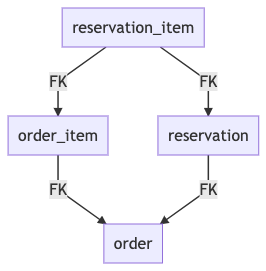昨天讲了第一个案例,今天讲一下第二个案例,今天的主要内容:
- Mysql锁概览
- 如何通过
show engine innodb status分析死锁 - 案例分析
Mysql中的锁的分类
Mysql的锁是一个老生常谈的话题,这里只会简单介绍,不会涉及详细的理论知识,在本文后面的案例分析阶段,会有这些知识的应用。
表锁
表锁是Mysql是Mysql Server层的实现,与Engine无关。
-- 对order和order_item加读锁lock table order read, order_item read;-- 释放锁unlock tables;
行锁
行锁需要Engine层的支持,我们用的最多的是Innodb引擎。行锁是针对某一行数据加锁,我们在上篇文章中也说到过,Mysql的行锁是加在索引上的。
行锁的粒度:
- LOCK_ORDINARY:也称为 Next-Key Lock,Mysql对行的默认加锁规则,相当于 RECORD + GAP。
- LOCK_GAP:间隙锁,锁两个记录之间的间隙,主要是为了防止在间隙中插入数据(update也可能会导致数据在一个GAP中插入)
- LOCK_REC_NOT_GAP:只锁记录,
- LOCK_INSERT_INTENSION:插入意向 GAP 锁,插入记录时使用,是 LOCK_GAP 的一种特例。
Mysql的加锁规则:
- 原则 1:加锁的基本单位是 next-key lock。next-key lock 是前开后闭区间。
- 原则 2:查找过程中访问到的对象才会加锁。
- 优化 1:索引上的等值查询,给唯一索引加锁的时候,next-key lock 退化为行锁。
- 优化 2:索引上的等值查询,向右遍历时且最后一个值不满足等值条件的时候,next-key lock 退化为间隙锁。
- 优化 3:唯一索引上的范围查询会访问到不满足条件的第一个值为止。
- 所谓“间隙”,就是由“这个间隙右边的那个记录”定义的
Mysql中锁的模式
上文中的表锁、行锁、行锁中的GAP、Next-Key Lock都是锁的类型,Mysql中锁的模式:
- LOCK_IS:读意向锁;
- LOCK_IX:写意向锁;
- LOCK_S:读锁;又称共享锁(Share locks),行锁语法
lock in shared mode - LOCK_X:写锁;又称排他锁(Exclusive locks,简称 X 锁),行锁语法
for update - LOCK_AUTO_INC:自增锁;特殊的锁,后面再写文章详细介绍。
注意Mysql不支持U锁(更新锁),Mysql中对于更新操作会先加S锁,再通过锁升级变为X锁。U锁表示有事务对该行有更新意向,只允许一个事务拿到U锁,该事务在发生写后U锁变X锁,未写时看做S锁。
案例分析
昨天的文章我们写到,我们优化了发号器后,发现还是会出现锁超时,而且通过show engine innodb status分析发现,迁移过程有死锁发生。我们来一步步分析一下。
背景
为了模拟事故现场,我这里准备了四张表order、order_item、reservation、reservation_item。表间关系:

建表语句:
create table `order`(id int auto_incrementprimary key,order_number varchar(10) null,user varchar(10) null,constraint order_order_number_uindexunique (order_number));create table order_item(id int auto_incrementprimary key,item_name varchar(30) null,price decimal(4, 2) null,order_id int not null);create table reservation(id int auto_incrementprimary key,comment varchar(255) null,reservation_number varchar(20) null,order_id int null,constraint reservation_reservation_number_uindexunique (reservation_number),constraint reservation_order_id_fkforeign key (order_id) references `order` (id));create table reservation_item(id int auto_incrementprimary key,reservation_id int null,order_item_id int null,constraint reservation_item_order_item_id_fkforeign key (order_item_id) references order_item (id),constraint reservation_item_reservation_id_fkforeign key (reservation_id) references reservation (id));
业务介绍:
- 一个业务会更新一个order下面所有order_item的价格
- 一个业务会插入reservation数据,并且插入对应的reservation_item数据
死锁分析
由于我们负责迁移任务,对业务库的表间关系不太了解。迁移过程中发现,有些事务失败了,数据没进去。错误还是上篇文章中的锁超时。
我们用show engine innodb status,输出如下(模拟的场景,并非真实场景,真实场景要比这个复杂的多):
------------------------LATEST DETECTED DEADLOCK------------------------2020-04-19 02:10:51 0x7fe5e86ae700*** (1) TRANSACTION:TRANSACTION 17192, ACTIVE 11 sec starting index read-------为了精简,删除了部分内容------------------------------------事务一执行的语句----------update order_item set price = 30 where id = 2*** (1) WAITING FOR THIS LOCK TO BE GRANTED:-------事务一想要获取的锁---------RECORD LOCKS space id 609 page no 3 n bits 72 index PRIMARY of table `test`.`order_item` trx id 17192 lock_mode X locks rec but not gap waitingRecord lock, heap no 3 PHYSICAL RECORD: n_fields 6; compact format; info bits 00: len 4; hex 80000002; asc ;;1: len 6; hex 000000004316; asc C ;;2: len 7; hex d3000001d3011d; asc ;;3: len 2; hex 4932; asc I2;;4: len 2; hex 9400; asc ;;5: len 4; hex 80000001; asc ;;*** (2) TRANSACTION:TRANSACTION 17193, ACTIVE 8 sec inserting-------为了精简,删除了部分内容-----------事务二执行的语句----------insert into reservation_item (reservation_id, order_item_id) VALUE (1, 1)*** (2) HOLDS THE LOCK(S):-------事务二持有的锁----------RECORD LOCKS space id 609 page no 3 n bits 72 index PRIMARY of table `test`.`order_item` trx id 17193 lock mode S locks rec but not gapRecord lock, heap no 3 PHYSICAL RECORD: n_fields 6; compact format; info bits 00: len 4; hex 80000002; asc ;;1: len 6; hex 000000004316; asc C ;;2: len 7; hex d3000001d3011d; asc ;;3: len 2; hex 4932; asc I2;;4: len 2; hex 9400; asc ;;5: len 4; hex 80000001; asc ;;*** (2) WAITING FOR THIS LOCK TO BE GRANTED:-------事务二想要获取的锁----------RECORD LOCKS space id 609 page no 3 n bits 72 index PRIMARY of table `test`.`order_item` trx id 17193 lock mode S locks rec but not gap waitingRecord lock, heap no 2 PHYSICAL RECORD: n_fields 6; compact format; info bits 00: len 4; hex 80000001; asc ;;1: len 6; hex 000000004328; asc C(;;2: len 7; hex 5d000001672eb5; asc ] g. ;;3: len 2; hex 4931; asc I1;;4: len 2; hex 9e00; asc ;;5: len 4; hex 80000001; asc ;;*** WE ROLL BACK TRANSACTION (1)
部分内容的解释:
lock_mode X locks rec but not gaplock_mode X排他锁locks rec but not gapRECORD 锁,行锁
lock mode S locks rec but not gap waitinglock_mode S共享锁locks rec but not gapRECORD 锁,行锁
从业务的代码中我们发现,两个事务的具体操作如下:
-- 事务一begin;update order_item set price = 30 where id = 1;update order_item set price = 30 where id = 2;commit;-- 事务二begin;insert into reservation_item (reservation_id, order_item_id) VALUE (1, 2);insert into reservation_item (reservation_id, order_item_id) VALUE (1, 1);commit ;
但insert操作为什么会需要一行的读锁呢?后面发现这个表其实有外键。所以猜测,插入操作,对于有外键的表,需要获取到主表(外键目标表)的目标行的读锁。后面查阅官方文档,发现外键检测确实会在目标行增加S锁。
If a FOREIGN KEY constraint is defined on a table, any insert, update, or delete that requires the constraint condition to be checked sets shared record-level locks on the records that it looks at to check the constraint. InnoDB also sets these locks in the case where the constraint fails.
解决方案
既然是外键检测出的问题,有以下三种解决思路:
- 我们只有一个业务是会更新order_item的,其他N项业务都只是插入。所以可以从业务需求入手,把更新操作前置。由于后面的业务只会获取S锁,不会互相阻塞。
- 删除外键,有不少的Blog说,外键已经不是一个好的设计了,你觉得呢?
- 关闭外键检测,但业务服务用的是Spring JPA,单个事务控制外键检测比较麻烦。
由于我们不是业务服务的开发人员,所以只能建议去除外键,并不能真正要求业务团队去除。所以采取方案一解决。

